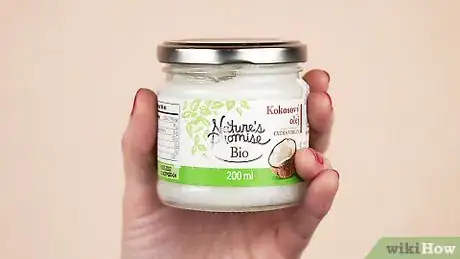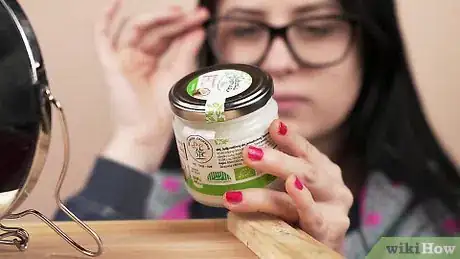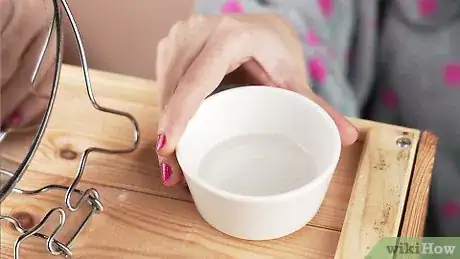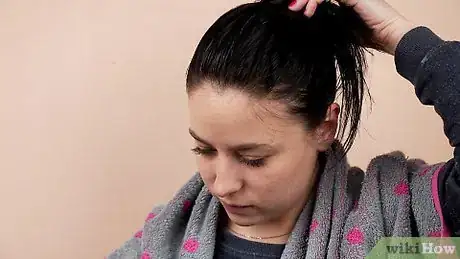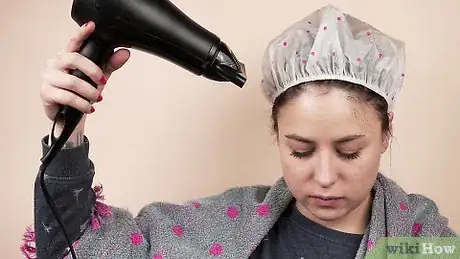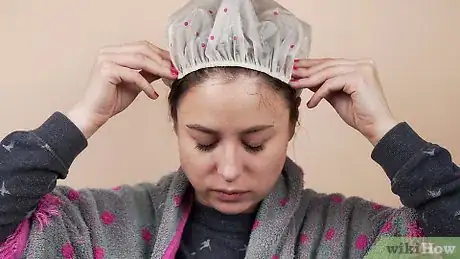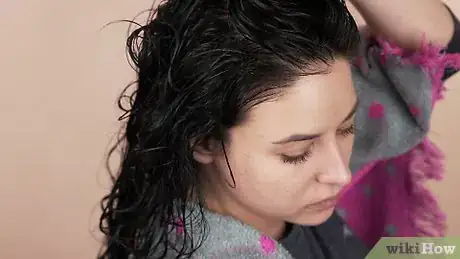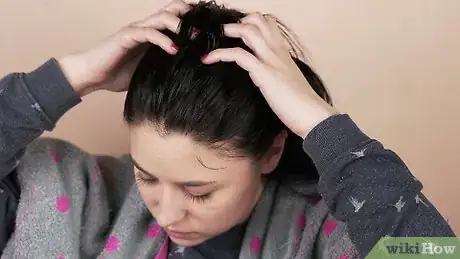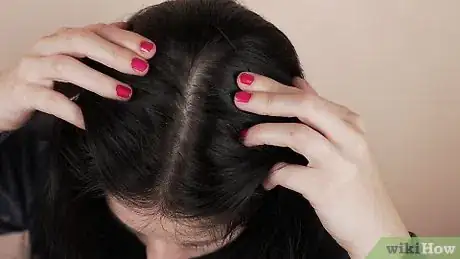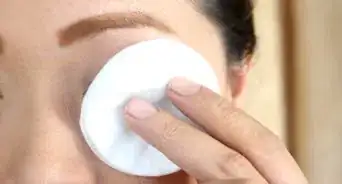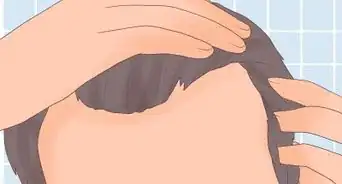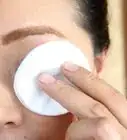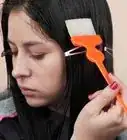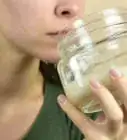This article was co-authored by Noël Reid-Killings. Noël Reid-Killings is a Professional Hair Stylist and the Owner of Noël New York Salon & Boutique. With over a decade of experience, Noël specializes in curating and customizing hair solutions for all hair types and textures. She has worked with countless A-list celebrities including Alicia Keys, Ciara, Yara Shahidi, and Simone Missick. Her work has been featured on makeover shows and in magazines including Essence, Sophisticates Black Hair, Teen Vogue, Elle, 21Ninety, WWD, POPSUGAR, Allure, The Cut, The Huffington Post, and Swaay.
There are 12 references cited in this article, which can be found at the bottom of the page.
This article has been viewed 149,211 times.
Coconut oil is unusual for its incredible ability to penetrate your hair shaft and strengthen hair.[1] This makes it ideal for restoring strength to hair damaged by heat, chemical treatments, or excessive dryness. Depending on your needs, you may use coconut oil before or after washing your hair, or treat your hair to a restorative hair mask.
Things You Should Know
- Use virgin or refined coconut oil to ensure there are no added ingredients. Melt the coconut oil to make it easier to apply.
- Put coconut oil in your hair to prevent water damage, prevent tearing, and restore strength and shine. Leave the oil in your hair for up to 8 hours.
- Rub coconut oil on your scalp to treat scalp infections or head lice. Avoid using coconut oil to treat dandruff.
Steps
Selecting and Melting Oil
-
1Select virgin or refined coconut oil. Any coconut oil will work, whether it's labeled for hair or cooking. There are many types, however, so use this guide to find a quality oil:[2]
- A *"virgin," "extra-virgin," or "unrefined" label means the coconut oil has no added chemicals. A high quality virgin coconut oil should be pure white when solid, and clear when liquid.
- A "refined" or unlabeled product has probably gone through an industrial process. There are high- and low-quality examples, but they are difficult to evaluate without researching the brand. These tend to have a more mild scent.
-
2Check the label for extraction information. Either type of oil can be extracted from the coconut in one of several ways. This is a little technical, and you can skip it without much harm done. For those interested in finding the perfect brand, here's a breakdown:
- "Centrifuged" oils tend to have a more mild scent, and little risk of damage.
- "Expeller-pressed" or "cold-pressed" oils range from mild to strong scented. Low-quality examples may have heat damage, which cause unpleasant burnt scents.
- "Direct Micro Expelled" (DME) oil tends to be high-quality, and created directly by coconut farmers. This may be difficult to find.
Advertisement -
3Melt the oil (optional). Virgin coconut oil melts at 76ºF (24ºC), so in temperate weather it may already melt as you apply it to your hair. If you prefer handling liquid oil, spoon about 2–3 tablespoons (30–45mL) coconut oil into a bowl. Place the bowl in a larger container and pour hot tap water into the larger container, until it reaches halfway up the bowl. The oil should turn liquid within a few minutes.
- Do not microwave the oil. While this probably won't make it less effective, it can make the oil dangerously hot.[3]
-
4Brush your hair. Knots and tangles will make applying the oil more difficult.[4]
In Your Hair
-
1Prevent water damage. As a pre-wash conditioner, coconut oil reduces hygral fatigue, or swollen, damaged hair caused by water exposure. It may also reduce damage caused by brushing and heat-treating wet hair. Massage a small amount of coconut oil onto the roots of your hair, and drag it down throughout all your hair. Make sure you use an old towel and no clothes as coconut oil stains clothes and towels. Leave the oil in for 10–20 minutes first to treat damaged hair as well. Keep it under a shower cap or plastic bag to prevent dripping and keep it warm. Wash and condition your hair as usual.
- Although your hair will be more resistant to damage, it won't be invulnerable. When convenient, avoid brushing and heat-drying wet hair to reduce damage.
-
2Prevent tearing. As a leave-in conditioner, coconut oil reduces damage caused by brushing or handling wet hair, and adds shine. Start with a pea-sized amount, and saturate the ends. Work your way up, adding a light layer to the middle and nothing at all to the roots.[5] Add a little more if necessary, but not so much that your hair feels greasy. Leave this in as long as you like.
- This technique will restore some strength to chemically treated hair, heat-damaged hair, and dry Afro-textured hair.
- If you have frizzy hair, this will tame your curls in the short term. However, since coconut oil penetrates the hair, your hair will frizz again over time. Mineral oil is more effective for this purpose, although it will not restore strength.[6]
-
3Restore strength and shine. A heavy application of coconut oil can restore strength and shine to dry, damaged hair. About once a week or whenever convenient, set aside some time for a big treatment. To start out, rub in the oil with your fingers, or dip a pastry brush into liquid oil. Massage it over all of your hair, focusing on dry or damaged areas.
- If you have thick or long hair, section it first and apply the oil in sections.
-
4Tie up your hair. After a heavy application, tie your hair up and keep it under a shower cap, plastic bag, or plastic wrap.
-
5Add heat (optional). Optionally, use a thermal cap or a steamer for 10–30 minutes to increase absorption.[7] You may also need a plastic cap to prevent burning and heat damage.
-
6Leave the oil in for 1–8 hours. Coconut oil might be the best oil ever at soaking into your hair. After just one hour, your hair can absorb about 15% of its weight in oil. If you have severely damaged hair, leave the oil in for six hours to increase this to about 25%.[8]
-
7Wash your hair. After you're finished with the heavy application, wash your hair twice and use conditioner to remove all the oil from your scalp and hair. The absorbed coconut oil will remain inside the hair shaft, protecting it from further damage.
On Your Scalp
-
1Fight scalp infections with coconut oil. Rubbing in coconut oil can be highly effective at fighting certain types of scalp infections, called dermatophytes.[9] Symptoms include a swollen scalp, abscesses on the scalp, or hair loss that leaves black dots of broken hair on the scalp.[10]
- Always talk to a doctor first when dealing with a serious medical problem. Talk to a doctor first if you already apply medication to your scalp.
-
2Apply coconut anise sprays to head lice. If you have head lice and prescription treatment (permethrin) has failed to get rid of them, a spray of coconut and anise may do the trick.[11] As always, a conversation with your doctor is a good first step.
-
3Avoid using coconut oil to treat dandruff. Although some people use coconut oil for dandruff, this is generally a bad idea. Dandruff is usually caused by fungus that feeds on your scalp's natural oils. Adding more natural oil may just increase the food supply.[12] Try a mineral oil instead, or other treatments.
Which Oil Is Best For Hair?
Expert Q&A
Did you know you can get expert answers for this article?
Unlock expert answers by supporting wikiHow
-
QuestionCan I put coconut oil on my hair daily?
 Noël Reid-KillingsNoël Reid-Killings is a Professional Hair Stylist and the Owner of Noël New York Salon & Boutique. With over a decade of experience, Noël specializes in curating and customizing hair solutions for all hair types and textures. She has worked with countless A-list celebrities including Alicia Keys, Ciara, Yara Shahidi, and Simone Missick. Her work has been featured on makeover shows and in magazines including Essence, Sophisticates Black Hair, Teen Vogue, Elle, 21Ninety, WWD, POPSUGAR, Allure, The Cut, The Huffington Post, and Swaay.
Noël Reid-KillingsNoël Reid-Killings is a Professional Hair Stylist and the Owner of Noël New York Salon & Boutique. With over a decade of experience, Noël specializes in curating and customizing hair solutions for all hair types and textures. She has worked with countless A-list celebrities including Alicia Keys, Ciara, Yara Shahidi, and Simone Missick. Her work has been featured on makeover shows and in magazines including Essence, Sophisticates Black Hair, Teen Vogue, Elle, 21Ninety, WWD, POPSUGAR, Allure, The Cut, The Huffington Post, and Swaay.
Celebrity Hair Stylist
-
QuestionWhat exactly is a pre-shampoo treatment?
 Megan16Community AnswerIt's when you put a mask or other kind of treatment on your hair and then shampoo it (instead of putting it on your hair after shampooing).
Megan16Community AnswerIt's when you put a mask or other kind of treatment on your hair and then shampoo it (instead of putting it on your hair after shampooing). -
QuestionCan coconut oil increase the hair growth?
 Community AnswerAny oil helps if massaged into the scalp, promoting the blood to circulate and stimulates the follicles. Try doing a pre-shampoo treatment once a week, your hair will grow easily and faster, since moisturized hair is less prone to breakage. Also try coconut oil on your hair after applying a lot of heat (straightening/curling).
Community AnswerAny oil helps if massaged into the scalp, promoting the blood to circulate and stimulates the follicles. Try doing a pre-shampoo treatment once a week, your hair will grow easily and faster, since moisturized hair is less prone to breakage. Also try coconut oil on your hair after applying a lot of heat (straightening/curling).
Warnings
- Very porous hair may end up feeling greasy or limp after a heavy application. [13] If this happens, use less oil next time, or apply it only to your scalp. (Do not apply natural oils to your scalp if you are susceptible to dandruff.)⧼thumbs_response⧽
- Coconut oil should only be used occasionally. Using it too often may cause unhealthy build-up.[14]⧼thumbs_response⧽
References
- ↑ Noël Reid-Killings. Celebrity Hair Stylist. Expert Interview. 25 November 2020.
- ↑ http://www.foodrenegade.com/how-to-choose-a-good-coconut-oil/
- ↑ http://thebeautybrains.com/2014/09/is-it-okay-to-melt-coconut-oil-in-a-microwave-oven/
- ↑ https://www.indulgeoessentials.com/the-best-way-to-oil-your-hair/
- ↑ http://www.hairbuddha.net/coconut-oil-as-a-leave-in-hair-conditioner/
- ↑ http://www.naturallycurly.com/curlreading/curl-products/mineral-oil-versus-coconut-oil-which-is-better/
- ↑ http://www.thenaturalhavenbloom.com/2012/10/deep-conditioning-effect-of-time-and.html
- ↑ http://thebeautybrains.com/2014/04/coconut-oil-in-hair/
- ↑ https://onlinelibrary.wiley.com/doi/abs/10.1111/j.1439-0507.1992.tb00895.x
- ↑ http://www.aafp.org/afp/2003/0101/p101.html
- ↑ http://www.ncbi.nlm.nih.gov/pubmed/19343362
- ↑ http://www.empowher.com/dandruff/content/can-oil-treatments-make-dandruff-worse
- ↑ http://www.naturallycurly.com/curlreading/curl-products/mineral-oil-versus-coconut-oil-which-is-better/
- ↑ Noël Reid-Killings. Celebrity Hair Stylist. Expert Interview. 25 November 2020.
About This Article
To use coconut oil for your hair, start by rubbing the oil into your hair with your fingers and massaging it all over in sections. Once your hair is coated, cover it with a shower cap or some plastic wrap to keep the coconut oil from dripping out. Then, leave the oil in your hair for between 1 and 8 hours so that the strands absorb the coconut oil. Finally, wash your hair with shampoo twice to get all the oil out, then use your normal conditioner. Repeat this process once a week to protect your hair from damage and add shine. For tips on how to use coconut oil as a scalp treatment, read on!

